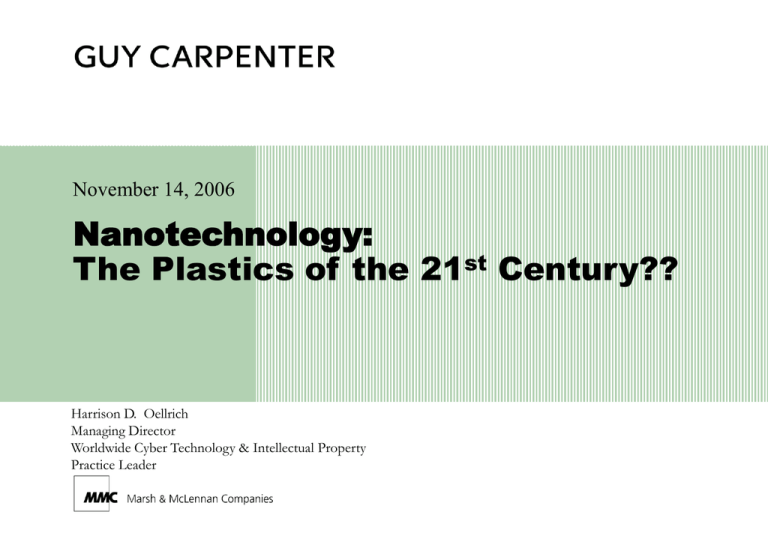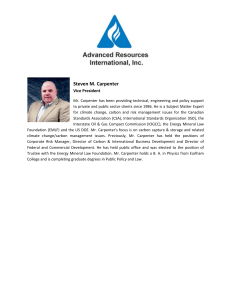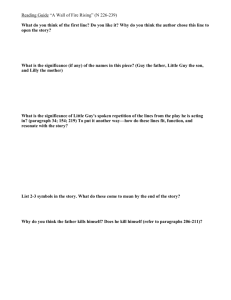Nanotechnology: The Plastics of the 21 Century?? st
advertisement

November 14, 2006 Nanotechnology: The Plastics of the 21st Century?? Harrison D. Oellrich Managing Director Worldwide Cyber Technology & Intellectual Property Practice Leader Agenda Introduction to Nanotechnology – What is nanotechnology? – Significance – Applications The Associated Risks – Occupational, environmental and consumer – (Re)insurance concerns The Actuaries Role – What (re)insurers need to know – How you can help your employers achieve their goals Q&A Guy Carpenter 2 An Answer To Many of Our Prayers? U.N. World Resources 2000 report on the 50 year outlook: – World population ↑ 50 % – World economic activity ↑ 500 % – Global energy and materials consumption ↑ 300 % “(Nanotechnology) holds the answer to most of our pressing material needs in energy, health, communications, transportation, food, water, et cetera” – Richard Smalley, Professor Rice University, Nobel Laureate Insurance = Enabler of technologies Guy Carpenter 3 The Potential: An Introduction to Nanotechnology What Is Nanotechnology? The term ‘nanotechnology’ is derived from the Greek word ‘nanos’ or ‘dwarf’. – 1 millimeter = 1,000,000 nanometer "Nanotechnology is the understanding and control of matter at dimensions of roughly 1 to 100 nanometers, where unique phenomena enable novel applications." – United State’s National Nanotechnology Initiative (NNI) Guy Carpenter 5 Achieving Nanosized Particles 2 general processes – “Top-down”: – “Bottom up”: Deliberate manipulation of matter by certain chemical and/or physical processes to create materials with specific properties that are not displayed in their larger forms Use of manufacturing processes such as milling or grinding to produce nano sized particles Nano-sized particles exhibit drastically different or superior properties Guy Carpenter 6 The Science Behind the Marvel As an object decreases in size, the ratio between surface area and volume increases. – Surface molecules are extremely reactive Classical physics breaks down at 50nm – Objects take on different chemical, biological and physical properties provoking altered optical, magnetic and electrical properties Guy Carpenter 7 Four Promising Nano Materials Buckyballs – Molecules containing carbon atoms bound together in a hollow sphere – Can enter cells as they pass easily through the blood stream Nano particles – Tiny particles consisting of a single element/compound – Contain properties different from bulk material from which they were derived Carbon Nano Tubes – Carbon atoms bound in long thin tubes – Enhanced conductivity / strength Quantum Dots – Nano sized crystals – Emit light after light is shone on them Guy Carpenter 8 Key Opportunities and Benefits of Nanotechnology Economic – 15 % of all global manufacturing output in 2014. – Will add $1 trillion to the world economy by 2015 – Louise Valle, Chubb Corp. Manufacturing – Miniaturization, intrinsic production, reduction of waste materials Environment – EPA: potential to reduce worldwide energy consumption by 14.6% – Can eliminate toxic waste at its source Medicine – Poised to revolutionize the ways that we detect, prevent and treat various diseases and medical conditions. Research – 2005 NNI R&D spending already nearly $1.1 billion Guy Carpenter 9 Irrational Exuberance?? Even if overstated all must agree that opportunities in this space are real and significant Guy Carpenter 10 The Future Is...... Which products utilize nanotechnology? – Some 200 consumer products presently on the market YES YES YES YES NOW!!! Guy Carpenter 11 The Risk: Understanding the exposures and risks from an (re)insurance perspective Risk Exposures Occupational – Source: Manufacturing, transportation, storage, use and discard of particles – Concern: Lack of protection, monitoring, filtration – Coverage areas: Workers compensation This is where the early health and safety concerns will arise: – Researchers – Scientists – Other lab / production workers Guy Carpenter 13 Risk Exposures Environmental – Source: Widespread applications → water basin, soil, air circulation – Concern: Complete penetration, concern over new non-biodegradable pollutants – Coverage area: Environmental liability Guy Carpenter 14 Risk Exposures Consumer – Source: Skin→ bloodstream, lung→ bloodstream, ingestion, drug administration – Concern: Penetration of brain membrane, disruption of immune system, unintended flow of particles throughout body, etc.. – Coverage areas: Product liability Guy Carpenter 15 Major (Re)insurance Concerns Insufficient research, knowledge = major uncertainties – No past data – Unforeseeable future Unanticipated side effects The asbestos parallel Long tail, chronic concerns – Cumulative loss nature – Extremely broad spectrum of application – Revolutionary rather than evolutionary Guy Carpenter 16 (Re)insurance – Innovation Connection Vehicle for bringing safe yet effective innovation to the marketplace – A certain social responsibility involved – Filters new risks and developments to general public Must stay cutting edge to protect customer - Enabler of technology Guy Carpenter 17 The Coverage: Helping Our Employers Achieve Their Goals What Do (Re)Insurers need to do? Insurers – Understand the technology and its processes – Understand the risks – Do the research into plausible and critical risks – Begin to formulate products and coverage Reinsurers – Understand the technology and its processes – Understand the risks – Become comfortable with the industry Guy Carpenter 19 Why Should The Insurance Industry Care? A win–win scenario : 1) Insurance coverage allows evolution of the technology, all mankind benefits 2) Establishment of coverage products for nanotechnology, new portfolio of business generated Guy Carpenter 20 Why General Exclusions Are Not The Answer Nanotechnologies cover a very broad field with far from uniform risk characteristics. Positive diversification effect for insurance portfolios based on variety and spread across industrial segments. The exposure of the general population to nanotechnologies is still very low. Guy Carpenter 21 Risk Awareness Bring discussion to the front line between insurers and reinsurers Help determine how underwriters and risk engineers should deal with critical issues Consult underwriters on unavoidable uncertainties of risks – No reliable probability curve – No reliable severity estimates Guy Carpenter 22 Risk Identification Can we underwrite the risks? Construct clear picture of risk landscape for clients Develop and evolve contract wording – Creation of new vocabulary and concise definitions – Specify certain exposures Facilitate research and risk awareness – Aid primary in decisions – Educate reinsurers Guy Carpenter 23 Risk Management It is everyone's responsibility to stay abreast of emerging exposures – Wait and see attitude is strongly unadvised – Close monitoring of risks Actuaries can/should be an integral component of teams set up to study/monitor/guide their companies response to Nanotechnology (or any other emerging exposure). Guy Carpenter 24 THANK YOU! QUESTIONS?





